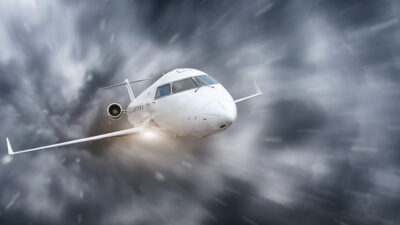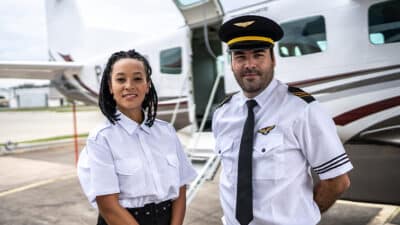Medical Advisory: Travel Safe, Travel Smart

It turns out that your mother was right. The things she always told you—wash your hands, be prepared, get plenty of rest, don’t drink too much, talk to someone if you’re hurt—were not just personal codes of conduct but also insightful tips for today’s airborne travelers.
By using the onboard medical equipment and following a small number of simple tips, both passengers and crew could significantly reduce the possibility of disease transmission while avoiding severe medical conditions accelerated by the inflight environment.
Wash your hands. Many organisms are deposited on hard surfaces and are waiting for passengers to liberate them. Touching the nose or eyes will give such organisms the new home they are waiting for. The U.S. Centers for Disease Control and Prevention reports: “Hand washing is the single most important means of preventing the spread of infection.” Not only should passengers wash with soap and water, and do so frequently during travel, but they can also carry disposable towelettes or alcohol-based hand-gel (minimum 60% alcohol) to clean their table trays and arm rests during flight.
Stay hydrated. The best hydration solution is water, not soft drinks or juice. Passengers should feel comfortable asking the crew members for water, which is generally in stock.
Limit alcohol. Oxygen deprivation is a natural effect of flying at altitude. As a result, crew members and passengers should limit alcoholic beverages the day prior to and of air travel. Cabin altitude, which is kept to 8,000 to 10,000 feet, can exacerbate respiratory problems and the effects of alcohol.
Be prepared. Pack medications in a separate carry-on bag for easy accessibility. From insulin and eye drops to antacids and blood pressure medication, passengers should be encouraged to carry their own “mini-medicine” kits on board to avoid possible medical situations. As a reminder, all prescription medications should be carried in the original containers with your name, the drug name, quantity and prescribing doctor’s name. This will also help when clearing customs and security checkpoints.
Move around. Circulation in the legs is important to help travelers avoid deep vein thrombosis (DVT) in which blood pools in the legs and causes dangerous clots. Flight attendants should encourage passengers to move about the cabin when it is safe to do so, especially on longer flights.
Speak up. Passengers should be encouraged to talk to a crew member if they see suspected signs of illness or injury prior to boarding or while in flight.
Communicating with passengers. So, how exactly does the crew communicate these vitally important messages to passengers? Consider one or all of these tactics:
- Increase the amount of health information on your company’s website
- Include health tips on seatback cards
- Create a travel safety article in your in-house newsletter/magazine or send an email reminder to travelers
- Add tips to your passenger’s travel itinerary
- Communicate health and travel advice to your in-house travel department
- Complete fit-to-fly assessments prior to flight
- Set a good example by washing hands and following these recommendations
Flight departments can assist your passengers by identifying the most common inflight medical incidents. Working with medical advisory personnel, crews have the ability to actively monitor data about the types of crew and passenger illnesses occurring on their aircraft. That information can then be used to create specific tips for prevention. There are other ways to be informed:
- Train on first aid & medical assistance annually
- Be aware of signs and symptoms of illnesses
- Know what medical equipment is on-board your aircraft and how to use it
- Use your resources: Ground-based medical assistance and medical facilities available at destination
- Have up-to-date health evaluations and get recommended immunizations
- Know health issues at destination
- Understand your travel health and medical evacuation insurance coverage prior to a trip
- Carry emergency phone contacts with you and let family or close friends know your travel itinerary
By taking a few precautionary measures and planning ahead, passengers—and crew—can reduce the chances of illness or delay, prevent inflight emergencies and travel the world safely. Travel safe, travel smart.
Medical Advisory is provided courtesy of MedAire, Inc., A Global Aerospace SM4 partner.
Resources available:
- Centers for Disease Control and Prevention (CDC)—www.cdc.gov
- MedAire, Inc.—www.medaire.com
- World Health Organization (WHO)—www.who.int

Flight departments around the world rely on MedAire, an International SOS company, to reduce their travel safety risks. Crews are trained on the resources to manage in-flight illness and injury with onboard medical equipment and telemedicine assistance. On the ground, passengers and crew have one resource for medical referrals; guaranteed payments for medical expenses; assistance with lost documents and prescriptions; online and e-mail travel advisories; evacuation support and a host of other services.
http://www.medaire.com/
© 2024 MedAire Worldwide. All Rights Reserved.
Next ArticleRelated Posts

Understanding the Challenge of Turbulence-Related Injuries in Business Aviation
The challenge of managing air turbulence in business and private aviation is becoming increasingly evident due to the growing number of turbulence-related incidents affecting aircraft operators across the industry.

A Flight Toward Well-Being: The Changing Landscape of Mental Health in Aviation
As the Global Director of Aviation Health at MedAire, I have witnessed firsthand the incredible strides our industry has made in addressing mental health issues among pilots.

